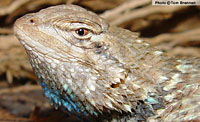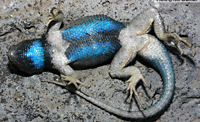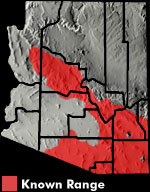Online Field Guide to The Reptiles and Amphibians of Arizona


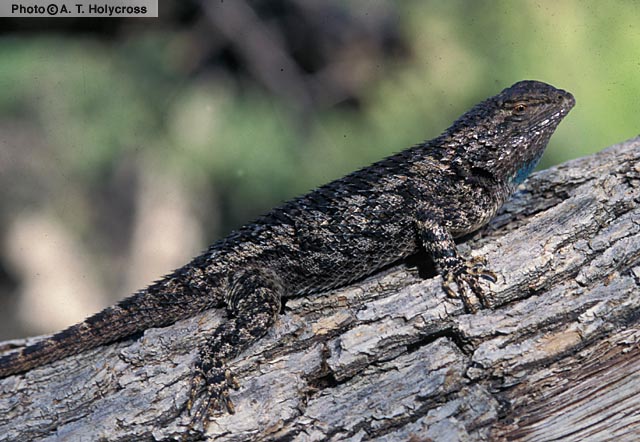
Hidalgo County, NM
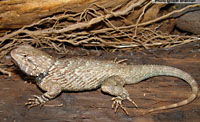 Yavapai Co., AZ |
| CLARK’S SPINY LIZARD Sceloporus clarkii | |
|
DESCRIPTION: A large (up to 144 mm or 5.6″ from snout to vent), stocky lizard with large, pointed, keeled, overlapping scales. Base coloration is blue-gray, gray, or gray-brown, often with powder blue or blue-green accents of the body and tail. A dark wedge-shape marks each shoulder and there are dark, bracelet-like crossbars on the forelimbs. Juvenile animals and females often have brown or gray crossbars on the body. Males have a large blue or blue-green patch on each side of the belly and one on the throat. These patches are often outlined with black. Belly and throat patches are faint or lacking in females. Its dark, wedge-shaped shoulder markings distinguish this lizard from Arizona’s smaller Sceloporus. The bars on its forelimbs distinguish it from the Desert Spiny Lizard. The similar Yarrow’s Spiny Lizard has a complete collar. DISTRIBUTION: This lizard ranges across sub-Mogollon Rim central Arizona, south-central, and southeastern Arizona at elevations ranging from 3,000′ to about 6,000′. HABITAT: Clark’s Spiny Lizard is found in a variety of biotic communities including Arizona Upland Sonoran Desertscrub, Semidesert Grassland, Interior Chaparral, Madrean Evergreen Woodland and Great Basin Conifer Woodland. It is usually encountered on lower mountain slopes, in foothills, and along riparian corridors. BEHAVIOR: This diurnal lizard is often spotted basking on the branches of trees. It is less frequently seen basking on boulders and rock outcroppings. When encountered this wary lizard scurries to the opposite side of the trunk and up into the safety of the high branches. It also seeks shelter under boulders and in crevices. It hibernates during the cold months of winter and late fall. DIET: Clark’s Spiny lizard feeds on a variety of insects including beetles, ants, caterpillars, wasps, moths, butterflies, grasshoppers, bugs, aphids, cicadas, and crickets. It also feeds on a variety of spiders and some plant material. REPRODUCTION: Mating takes place in spring and a clutch of up to 28 eggs is laid in June. Some females may lay an additional, smaller clutch of eggs. By Thomas C. Brennan Brennan, T. C., & A. T. Holycross. 2006. A Field Guide to Amphibians and Reptiles in Arizona. Arizona Game and Fish Department. Phoenix, AZ Brennan, T. C., & A. T. Holycross. 2005. A Field Guide to Amphibians and Reptiles of Maricopa County. Arizona Game and Fish Department. Phoenix, AZ Stebbins, R.C. 2003. A Field Guide to Western Reptiles and Amphibians, Third Edition. Houghton Mifflin Company, Boston, MA. |
|
Visit Partners in Amphibian and Reptile Conservation:


HOME
Copyright © 2023, Arizona Game and Fish Department. All rights reserved.
If you make use of the textual contents of this site in reports, publications, etc. please cite and credit the author(s) and photographer(s). All photos on this website are copyrighted. However, those found in the species account section may be used for any noncommercial scientific, educational, or conservation purposes provided that photographs are not altered and continue to bear the copyright symbol and name of the photographer. Please contact the photographer regarding commercial use of copyrighted photographs.










